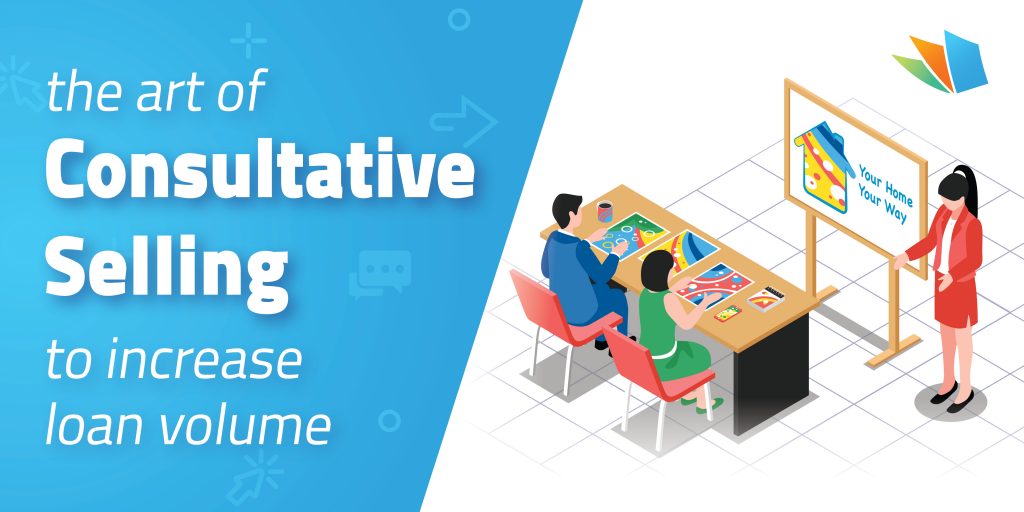 Consultative selling may not sound as flashy or exciting as “sales machine” or the “art of the sale” but it’s certainly in the same category. Consultative selling in the mortgage industry is a tactic where you act more like an expert guide rather than a salesperson.
Consultative selling may not sound as flashy or exciting as “sales machine” or the “art of the sale” but it’s certainly in the same category. Consultative selling in the mortgage industry is a tactic where you act more like an expert guide rather than a salesperson.
It’s also how most top-earners close a significant portion of their mortgage leads.
To get an idea of how consultative selling differs from a traditional mortgage selling approach, think about the last time you purchased an appliance. A typical salesperson might try to push that month’s deal or the product they’ll get the most commission from –and you would know it too!
They probably wouldn’t ask too many questions or would rush you to apply for credit. How likely would you be purchase?
In contrast, a salesperson using a consultative selling approach would first find out what you are looking for, your budget, your lifestyle, personal tastes –and act more like your partner in finding the right product.
Psychologically, consultative selling also works because it feels less threatening and more respectful. The guards are down and the trust goes up, making it easier for the prospect to apply for the loan, not just comparison shop.
Learning to master consultative selling (also called solution-based selling) to close more loans begins with a mindset that you are an advocate for the prospect before the loan product you’re trying to sell.
This is much more than just lip service as we know that many times there IS a loan product that the mortgage pro is encouraged to push. However, with consultive selling, you must come in with a mindset that your prospect’s needs come before the status quo.
Here’s how to do that.
Selling More Mortgage Loans with Solution-Based Selling
Now that we’ve established that consultive selling focuses on the prospect needs and not a product, let’s go over the six simple principles of the consultative selling:
- Research
- Ask
- Listen
- Teach
- Qualify
- Close
1. Research
The research phase of consultative sales has to do with how you acquired the mortgage lead in the first place. Did they contact you as a referral for VA loans? Did they contact you after reading an article about refis? Were they a lead you paid for?
Understanding where they first learned about your is just as important as what mortgage product they want. For example, a paid lead from a source that promotes a lot of FHA loans is different than a lead that contacted you because of a Yelp review.
Once you know where they came from, then you know what questions you should be asking.
2. Ask
This phase is where you will ask open-ended questions. Although you probably already know quite a bit about them (maybe they filled out your digital 1003) don’t assume you know everything. By using open-ended questions, you allow the prospect to volunteer the information. This not only gives you a clear picture of their needs but it also creates trust.
Open-ended questions are those that start with Who, What, Where, How, Why, and When. Closed-ended questions are those that use words like Do, Are, You, and Can.
Avoid the latter.
During the questioning, you’ll also discover what their goals are, uncover possible challenges, and their timeline, their budget, and the level of knowledge about the loan process.
But all this questioning is only as good as your listening.
3. Listen
Listening with intent is probably the best advice any salesperson can follow. Active listening focuses on the person talking and responding to make sure that you understand them correctly.
Listen to understand.
It will involve a lot of “parroting,” but remember that you’re just not repeating to make the prospect feel heard, you genuinely need to understand what’s communicated.
4. Teach
As you’re actively listening and responding, looking for opportunities to teach. Not just about the loan product, but to help them address their challenges and reach their goals.
True, this will likely involve discussing the loan product or service. But still, the focus should be on helping not pushing a product.
Remember not to give away too much knowledge! Too much too soon is overwhelming. Balance your expertise with the answers they give to your questions.
5. Qualify
Qualifying a lead is all-encompassing and should be done right from the start. When you “qualify a lead,” you’re assessing whether they are the right person to be sold to, in the right frame of mind to be sold to, can afford what you are selling, and in the market for the product.
The goal is NOT to try to convince the lead, but rather to determine early on whether the lead is not the right fit for your product or service.
Once you qualify the mortgage lead, it’s time to move to the closing sequence.
6. Close
Now that your qualified the mortgage lead, have built a rapport with them and presented them with the loan product that genuinely is the best option for them, it should be relatively easy to bring the loan to a close.
By sticking to the principles of consultative selling and qualifying a lead, then closing will feel natural to both you and the mortgage prospect. If pushback occurs, refer back to the challenges they should’ve shared during the “asking” phase.
Did you find this article helpful! Then you should check out our catalog of digital mortgage products! We give you all the digital tools you need to support your goals for closing more loans in 2020.

Pingback: Mortgage Industry Tips: Strategy and Tools to Work Remotely | LenderHomePage
Pingback: Loan Officer Sales Tips to Improve Your Sales Process